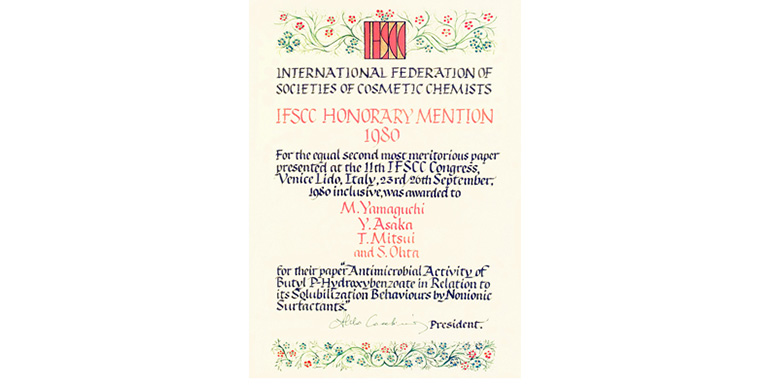- Home
- INNOVATION
- Introducing IFSCC Research Awards
- What are the preservatives that protect cosmetics from unwanted bacteria?
What is the paraben in cosmetics?
What are the preservatives that protect cosmetics from unwanted bacteria?
The 11th IFSCC Congress 1980, Venice Honorable Mention
Antimicrobial Activity of Butyl P-Hydroxybenzoate in Relationship to its Solubilization Behaviors by Nonionic Surfactants

What’s possible with the technology?
The compatibility between preservative and cosmetic components and the optimal amount in formulation was discovered for safer, more reliable products!
Like food, cosmetics contain lots of water and nutrients. This makes cosmetics prone to invasion by mold and bacteria, which may cause changes in odor and decomposition. There are two types of contamination from microorganisms: primary contamination that occurs during manufacture at the plant, and secondary contamination that occurs during the use by customers. While primary contamination can be prevented by hygiene control at the production site, secondary contamination occurs from customers handling the cosmetics or leaving the lid off the product. This indicates that the formulation of an optimal preservative is an effective means in protecting cosmetics from microorganisms.
However, there are many types of preservatives available, and the rationale behind the optimal types of preservatives and amounts for formulation was not clear in the 1970s when we received the award. This award-winning research focused on the properties of preservatives and the difference in preservative capacity even when the same type and identical preservatives are included in different products, leading to research on the interaction between preservatives and other components. As a result, we discovered the standards for determining the optimal formulation of preservatives for each product, enabling us to offer even safer and more reliable cosmetics.
What are the details of the research?
Careful investigation of individual properties and compatibility of preservatives. Comprehensive research of preservatives in almost all of the products available at present!
There are different types of preservatives; however, in this research we focused on paraben, which is found in cosmetics and natural matter and often used in pharmaceuticals and food. Studies were conducted on the difference in preservative capacity with different combinations of preservatives and cosmetic components. Since an emulsion (mixing of water and oil) is an essential technique in the development of cosmetics, we studied the amount of preservatives soluble in the surfactant required for this process, as well as the impact of this dissolution.
The results of the research led to the discovery of the compatibility of preservatives with other components and clarified that preservative capacity changes depending on the components and surfactants used. And, as a result of persistent research over many years, we finally established an indicator for calculating the optimal preservatives for each cosmetic formulation. This led to the formulation of preservatives based not only on preservative capacity, but also on safety, solubility in products, and compatibility with the product. The details of the research are still being used as a basic indicator for the formulation of preservatives in almost all products. Nowadays, there are programs that calculate the optimal preservative to be used and its amount by simple entry of the ingredients to be formulated.
ABOUT US
- Who we are
- History
- Profile
- Governance
- Quality Management
- Supply Network
- Region/Business
BRANDS
- Prestige
- Premium
- Inner Beauty
- Life Quality Makeup
SUSTAINABILITY
- Strategy / Management
- Society
- Environment
- Governance
- Reports / Data
- Related Information
INNOVATION
- Research and Development
- Research Areas
- Research outcomes
- Product safety
- Product Development Policy
- Initiatives for doctors and researchers
CAREERS
INVESTORS
- IR Library